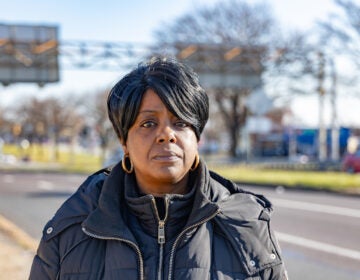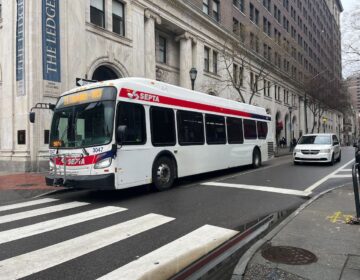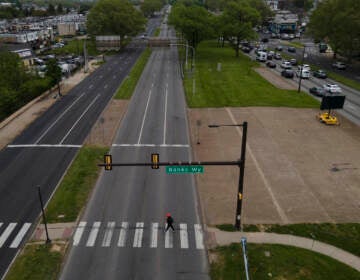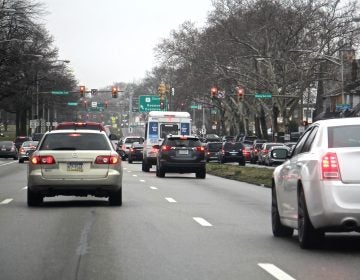Roosevelt Boulevard’s speed cameras have been ‘overwhelmingly successful.’ It’s still Philly’s most dangerous road
More changes to improve pedestrian and traffic safety on Roosevelt Boulevard are on the horizon.
Listen 1:13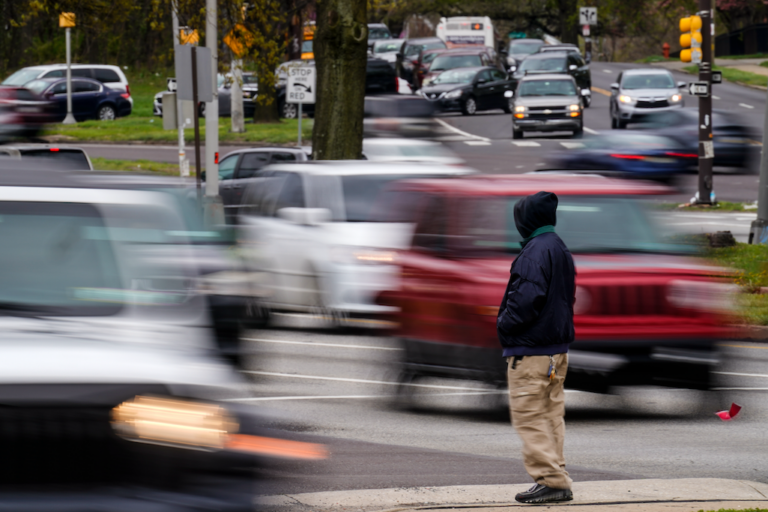
A pedestrian waits to cross Roosevelt Boulevard, in Philadelphia, Tuesday, April 19, 2022. Roosevelt Boulevard is an almost 14-mile maze of chaotic traffic patterns that passes through some of the city’s most diverse neighborhoods and Census tracts with the highest poverty rates. Driving can be dangerous with cars traversing between inner and outer lanes, but biking or walking on the boulevard can be even worse with some pedestrian crossings longer than a football field and taking four light cycles to cross. (AP Photo/Matt Rourke)
Have a question about Philly’s neighborhoods or the systems that shape them? PlanPhilly reporters want to hear from you! Ask us a question or send us a story idea you think we should cover.
For years, Roosevelt Boulevard, which runs from North to Northeast Philadelphia, has been known as one of the most dangerous streets in the city.
In 2020, the city installed cameras on the boulevard that automatically ticket drivers traveling more than 11 miles per hour over the speed limit. In a recently published journal article, the city and local researchers estimate that the cameras have significantly reduced crashes, injuries and deaths.
But Roosevelt Boulevard remains one of the city’s most dangerous roads. The city plans to redesign parts of the boulevard in the coming years, as well as bring the speed camera program to other roadways.
The city found that most of the crashes on Roosevelt Boulevard happen because of drivers speeding or driving aggressively. Four years ago, the city introduced automated speed cameras, which automatically ticketed drivers after a two-month grace period where drivers only received warnings.
Christopher Puchalsky oversaw the speed camera program as the director of policy and strategic initiatives at Philadelphia’s Office of Transportation, Infrastructure, and Sustainability.
“This is the first time they were being used in Pennsylvania, so the whole state was watching what we were doing here in Philadelphia,” Puchalsky said.
The city worked with researchers at the University of Pennsylvania to study what difference the speed cameras made. They found that the cameras led to 95% less speeding along Roosevelt Boulevard, which is a much larger impact than other speed camera programs have achieved, according to the research literature.
“The cameras had been overwhelmingly successful, more frankly than we had hoped for,” Puchalsky said. “I think that speaks to just how out of control the speeding was on Roosevelt Boulevard before we installed them.”
Erick Guerra, associate professor of city and regional planning at the University of Pennsylvania and a co-author of the latest study, agrees.
“Enforcement works particularly well when a place is dangerous to begin with — Roosevelt Boulevard is consistently the most deadly street in Philadelphia,” he said.
Guerra added that since 2020, there has been much more aggressive and dangerous driving in Philadelphia, so any extra enforcement will have a larger effect.
“We’re just driving in extremely dangerous ways,” Guerra said. “It’s tangible and it’s very visible in Philadelphia’s traffic fatality rate and in its overall traffic safety record.”
Despite the improvements, the study notes that Roosevelt Boulevard remains the most dangerous road in Philadelphia. Puchalsky said the city has more changes planned, including a plan to redesign parts of the road. The goal is to choose some designs this year, make revisions next year and start construction in 2027, he said.
One suggested change is to extend and realign curbs so that pedestrians can cross the street at a right angle and not have to walk as far across traffic.
Puchalsky said the city is also studying some concerns residents have raised about drivers driving dangerously on parallel streets instead of Roosevelt Boulevard to avoid tickets, or hiding license plates.
Recently, Pennsylvania lawmakers approved of Philadelphia working with PennDOT to add speed cameras to more roads. This would come after studying locations where there are more speed-related crashes, consulting the public and going through City Council.
Puchalsky said he has also heard from his counterparts in Pittsburgh about setting up a speed camera program there.
“They are extraordinarily effective,” he said. “We saved something like 36 lives or more so far on Roosevelt Boulevard. But how do we scale that? Because we have a traffic safety crisis throughout the state.”
WHYY is your source for fact-based, in-depth journalism and information. As a nonprofit organization, we rely on financial support from readers like you. Please give today.




